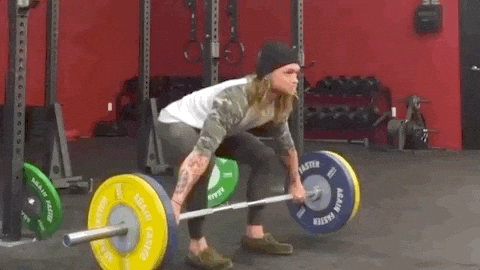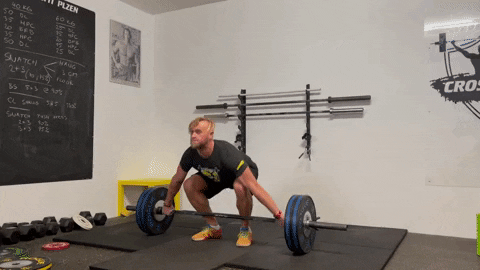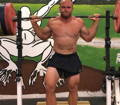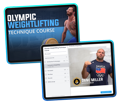Strength training in Olympic Weightlifting
FREE WEIGHTLIFTING WORKOUT!
Download by entering below

Strength Training For Olympic Weightlifting
The needs for Olympic weightlifting are incredible. We have to know that there is technical skill and technical precision involved. Coaches needed to hone their craft so that the weightlifters can zero in on specific areas to improve their movement.
We know that athletes need a large amount of absolute strength to improve weightlifting performance. We know that there is a correlation between back squats and cleans, front squats and cleans, and pulls and how snatches and cleans are hit. We also know that accessory work has to be extremely precise to improve structural integrity. Targeting specific areas based upon limb lengths and past athletic experience, we have to have proper accessory work put into place. Finally, weightlifters need to be athletic. They have to be explosive and able to recruit a large amount of high threshold motor units at a very fast pace.
We need to understand all the different tasks weightlifters have to do: technical coordination, absolute strength, accessory work, and being athletic. All this needs to be understood to develop solid weightlifters.
Focus On Technique
Weightlifters lacking in technical precision will not be able to perform. Start by establishing a technical model. Pick an athlete who moves well. Lu Xiajuon, Hsing Chun Kuo, Hayley Reichert, and Norik Vardanian are all great athletes to choose from to be guides for weightlifters to emulate. The weightlifters can see how the athletes move and work towards the end goal moving like the selected technical model.

From the technical model, we can start to pick variations and a couple of different technical cues to get the athlete to move like their technical model. In the process, the athlete will still have their style and flair.

Strength Focus
Let’s start by looking at the 80% rule.
An athlete’s snatch should be 80% of their clean, ideally. For some people, their snatch is as high as 86% of their best clean. Some it is lower. It might be 77%. Ideally, the snatch is 80% of an athlete’s best clean and jerk.

We want to see the athlete’s best clean be about 80-85% of their best front squat. Some people can occasionally clean their best front squat. Yuri Vardanian is known for basically being able to clean and jerk his best front squat. Typically, athletes will be able to clean and jerk their best 5 rep front squat; it is around 80%, sometimes it is around 85 to 90%, and sometimes it is even below 80%.
Sticking with the 80% rule, an athlete’s front squat should be about 80% of their best back squat.
Using these numbers, we can figure out where an athlete falls on the spectrum of strength to try and close the gap so that the athlete is more efficient relative to their numbers.
Accessory Based Strength Training
Typically with accessory work, we are thinking of bodybuilding style work, maintenance work, mobility work, and lower back work.
I like to look at two different aspects. One, what are the problem areas going to be for weightlifters? Without fail, it is going to be the back, knees, and shoulders. We have to create some sense of a program that has reverse hypers, glute-ham, mobility for the back, sled work, Spanish squats, DB external rotation work, and making sure the upper back is being mobilized as well.

The second factor, outside what joints are taking a pounding in the sport of weightlifting, is that we have to bring in the limb lengths of the individual. For instance, a long leg individual who can pull very well but has cleans or snatches crash on them so they have stress in their knees. Or do we have a shorter-legged athlete who gets more stress on their back because they’re not very good pullers? We have to understand how limb length impacts designing the strength-based program.
Athlete Day
Weightlifters have to focus on being athletic. We need to see how much unilateral work an athlete needs and we need to see how much bilateral, explosive work an athlete needs. Weightlifters who split jerks will favor one side over the other, as evidenced by a squat rotating to one side or an athlete being unable to put their feet back evenly without looking at them, they are favoring one side over the other. That information indicates a need for unilateral plyometric work that focuses on the non-dominant side in the split to alleviate some of that stress.
We also know weightlifters need to have a lot of dynamic trunk control. Weightlifters hit big splits and snatches with lots of weight overhead. Their trunks need to be stable with the weight overhead. That goes into high-intensity, chaos coordination movements in the form of plyometric movements that have a focus on dynamic trunk control.
Application
The sport of weightlifting is the snatch and clean and jerk. So, we should probably snatch and clean and jerk daily. I have my athletes do both daily. Now if an athlete has a glaring problem, we might focus on a specific area. For instance, maybe we just do split jerks on a day because the movement is horrible for an athlete.
With the snatch, I like to have 1 heavy day, 1 technical day, and 1 day where we auto-regulate (can go heavy or stay technical and imprint good movement). With the clean and jerk, I want to have 1 heavy day, 1 moderate day, and 1 technical day. These are done on the same day so the sequence pairing of heavy and technical in one lift can be played creatively. In this manner, the competitive movements are focused on three days a week.
That takes us to the variations which are performed two days a week. Finding problem areas, like arm bending, looping the bar, or jumping all over the place, we can find variations that break down the specific problems to improve overall technique. As a big competition approaches, we can use the variations that elicit a monster response to improve the competitive movements. Variations are used to iron out any issues with the technique.
Next is strength-based work. Improving a back squat, front squat, or pulls, I recommend trying to use heavy back squat or front squats around lighter days or where a rest day follows it up. I also like to have athletes back squat the day after a rest day. Also, on a day when just split jerks are performed, it is a great time to push a front squat because the athlete did not execute a clean.
The athlete development day is done once a week to give a refresher and break from the heavy lifting.
Recap
Weightlifters need technique, absolute strength, and a structural stable body. A technical model must be established and the use of the 80% rule can be used as a baseline to figure out where weaknesses and strengths are located. Use technical variations and strength movements to improve technical patterns. And always try to train with a day of athleticism every single week to lead to bigger responses.
Related Posts
Blog Topics

Yo, It's Dane
Welcome to the Garage Strength Blog, where it is my goal to provide you with the experience and knowledge I've gained in the strength and conditioning world over many years of learning from both successes and failures. I train elite-level athletes in a multitude of sports from the high school to professional levels, already producing 5 Olympics and 30+ National Champions. If you want to be the next champion I train, check out my strength programs below!
Start Training With Me

Join for free educational videos EVERY WEEK on strength coaching and athletic performance



